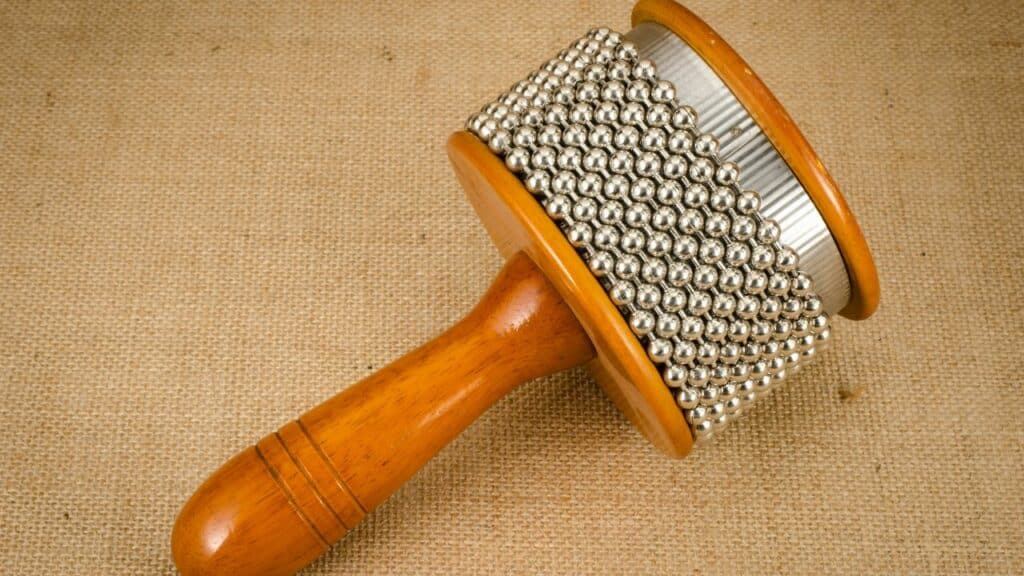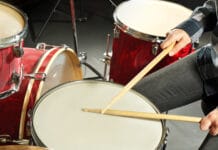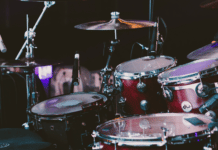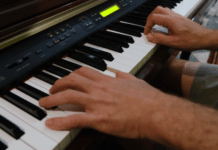From far away, it looks a little like a cheese grater. When you get closer, it looks like a dough embossing roller. What could it be? You’re looking at a cabasa instrument, an idiophone with a wooden handle, a stainless steel cylinder, and steel beads.
What Is a Cabasa Instrument?
The cabasa is a popular hand percussion instrument capable of producing several different and engaging rhythmic sounds. It comes with a wooden handle that you grip with one hand. Attached at the top of the handle is a hollow but textured cylinder or textured steel.
Today’s cabasa is a modernized version of the shekere, a traditional African gourd instrument with beads or shells netted together. Variations of the shekere, including the sizeable Nigerian agbe, have been played on the African continent for thousands of years. Gourd instruments are in the idiophone family, encompassing anything constructed to produce sound from the vibration of its entire body.
Fun Fact: An instrument that produces a sound by hitting its membrane is a membranophone. Cabasa is not a membranophone but an idiophone because it makes sound by vibrating the instrument itself.
Who Invented the Modern Cabasa Instrument?

Originally, artisans fashioned the soundboxes of ancient cabasa-type instruments from various gourd species. Later on, wood became a common material because it was thick, sturdy, and plentiful.
Fast forward hundreds of years and across the Atlantic Ocean. One day inside an elevator, Martin Cohen, the engineer/percussionist and the founder of Latin percussion, took notice of the textured stainless steel patterns. Imagining the potentially pleasing resonance of metal balls sliding around the surface of a metal soundbox, he began to experiment. He found that the amplification capability of the metal was enhanced by knobby and ribbed surfaces. The outcome? His company Latin Percussion patented the instrument.
Dubbed the LP Afuche®/Cabasa, it is now wildly popular in Latin jazz because of its durability and versatility. The Afuche®/Cabasa is not shy; it totally embodies the exuberance and color of Rio during Carnaval.
How Does It Produce Sound?
Cabasas produce sound when the beads or balls jiggle rhythmically over the surface of the hollow cylinder. Its unique rhythmic scraping sounds have the effect of capturing the attention of people of all ages and backgrounds. The instrument creates an amazing number of sounds because you can shake it, stroke it, tap it, rub it, spin it, hit it, twist it, roll it, and wave it around.
The many types of cabasa each sound different, depending on cylinder diameter, steel ball size, chain weight, and the number of chains. Some cabasas have flanges — protruding rims extending from the top and/or bottom of the cylinder over the chains.
Flanges provide more percussive surface area for players who enjoy taking advantage of the altered shape. Some cabasa players like to use foot pedals, either standard drum set pedals or custom-made. While foot pedals reduce the amount of variety in playing techniques, they provide a steady beat. They also free up the musicians’ hands to play other instruments.
What Does It Sound Like?
Some people describe the cabasa as sounding like an excited rattlesnake. It might also remind you of buzzing bees or a baby rattle, or maracas. It has a repetitive dry, penetrating sound like the güiro, a Latin American gourd idiophone. Both the güiro and the cabasa make a similar ratcheting, scraping percussive sound.
The size of an instrument definitely affects the music it produces. A standard-size cabasa produces a generally bright sound. Since larger models have bigger sound boxes, they generate fuller sounds and greater volume. On the other hand, smaller models, such as those crafted for children, make softer volumes and higher-pitched sounds.
Aside from size, the instrument’s form also determines the instrument’s range of abilities.
For example, the presence of flanges extending the cylinder edges tends to mellow and soften the vibrations. Cabasas with sound ports — holes on the top and bottom of the cylinder — project the vibrations just as the soundhole of an acoustic guitar does.
Any instrument’s raw construction material affects the music as well. Martin Cohen’s Afuche®/Cabasa revolutionized the music world because metal changed the nature of the humble shekere. Its music is loud, crisp, and vivid, piercing the orchestration around it.
Finally, different playing techniques affect the way the instrument performs. When listening to a piece of music that includes a calabasa percussionist, try to identify the following qualities:
- Basic rhythmic pattern
- Variations in rhythm
- Pauses
- Volume
- Changes in volume
- Projection and intensity
- Timbre — the quality that makes a sound unique
- Harmony vs. contrast — the support or divergence in relation to the accompanying music.
How to Play a Cabasa Instrument

You can appreciate almost anything better if you explore learning how to do it yourself. Here are the basics:
- Start by wrapping the fingers of your dominant hand around the handle of the cabasa.
- Shake it.
- Add accents while shaking the cabasa by striking it against the heel of your other hand. Vary the rhythm by striking on every other beat, every fourth beat, whatever comes out.
- Next, cup the beads or balls by curling the fingers of your non-dominant hand around the cylinder.
- Use your wrist to twist back and forth to produce a scraping sound.
- Another trick to try is loosely holding the handle and raising your hand up while rotating your wrist. Your arm should make a shallow arc, ending with your palm facing outward. Then reverse the process: lower your hand and let the chains slide back into place.
- A simple but interesting move involves pointing the handle outward in front of you. With your dominant hand, grasp the top and bottom of the cylinder on the side. Then your non-dominant hand cups the chains opposite your other hand. To make idiophonic music, your dominant hand holding the outside of the cylinder moves downward. At the same time, your non-dominant hand pressing against the chains pushes them sharply upwards. Reverse direction. Repeat.
- Combine techniques to build a variety of rhythmic patterns.
Tip: Don’t sweat deciding which hand is dominant and which is non-dominant. Your brain can often work better when you let it do its thing instead of agonizing over detailed directions. You can experiment to discover which hand prefers doing what.
Give It a Shake!
You’ve probably been listening to the cabasa instrument all of your life without knowing what it was. Maybe you were even enjoying it before you were born. Now that you know, you’ll probably want to hear more. And dance. And maybe even learn to play it yourself!
Table of Contents





